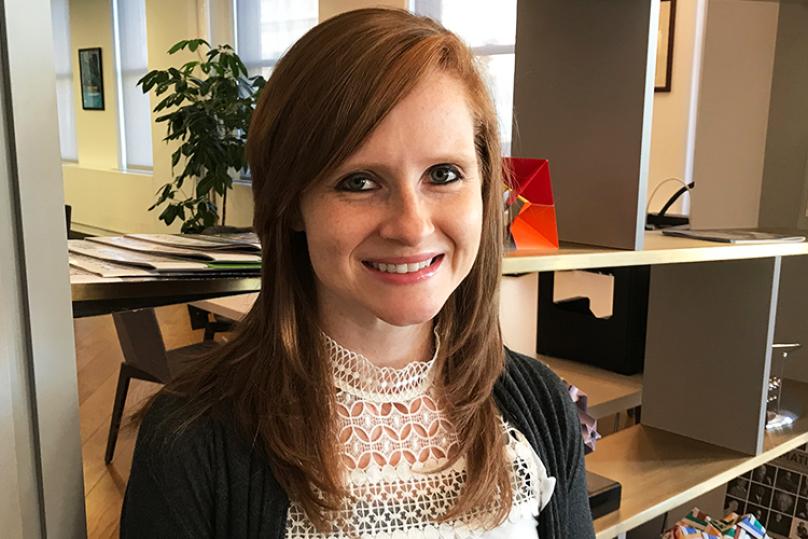
By Jeanne Kopun, MƒA Master Teacher
After a full day of teaching, I used to eat meals on the train to get to my graduate classes on time. I lost three pants sizes between 2007 and 2008 because I wheeled a laptop cart around a massive school building, sprinted from work to night classes, and ran back home to lesson plan. Whenever my mentor would ask me how I was doing, I would just say that everything was fine; I was so frazzled that I didn’t even know what to ask him. Such is the life of a first-year teacher. I’m sure we all have our own memories of trying to make it when starting out in this profession. However, this was more than ten years ago. Now, from my experience mentoring younger teachers, it feels harder than ever to become a teacher. Currently, teachers are thrown into the deep end right from the start after completing limited observations and student teaching. This was certainly a rude awakening for me having endured the same trial-by-fire. They also have challenges that I did not face when I began my career due to new certification requirements.
I often find myself asking: Why would anyone want to become a teacher now?
Two years ago, I overheard a few new teachers discussing the edTPA. This was like another language to me. Teachers who now apply for certification not only have to complete required coursework, workshops, and testing to earn their institutional recommendation to teach, they are obligated to submit the edTPA, a “student-centered multiple measure assessment of teaching.” This is a portfolio of work that includes videos of classroom interactions. When I spoke to several untenured teachers, they shared that the edTPA felt more like a “hazing process” rather than a measure of teacher performance. One newer teacher felt that the edTPA was an endurance test. The tasks in the portfolio of work were repetitive and time-consuming and did not make this teacher feel as if she learned anything as a new educator. Others felt that the test was an assessment of whether one had the ability to follow directions correctly, down to correct font usage. In response to failure rates, especially among minority students, alternative assessments to the edTPA were administered in previous years. Currently, the New York State Board of Regents has agreed to lower the passing score of the edTPA. Additionally, if prospective teachers fail the edTPA but meet other criteria, such as achieving a certain GPA and passing other exams, they can still be considered as a candidate. Public comment is still ongoing for these regulations that were passed on an “emergency basis” due to potential teacher shortages. These new measures may become permanent in December. Even with a lowering of the bar, the edTPA is not the answer to determining teacher quality. A different assessment needs to be developed that actually rates teachers on what matters: connecting with students and teaching them.
The Learning Policy Institute estimates that there could be a nationwide teacher shortage of 112,000 teachers by next year with enrollments in teacher preparation programs dropping 35 percent between 2009 and 2014. Some states have already taken steps to make their certification requirements less stringent as a result of this shortfall, including Minnesota, Arizona, Illinois, Utah, and Kansas.
It is disconcerting to see so many leaving our profession. Requirements to become a teacher should be demanding and actually assess one’s ability to educate children. Even if teachers get over the hurdle of a bureaucratic and dumbed-down certification system, they are met with the real demands of teaching and may be unprepared for them. It is easy for experienced teachers to get caught up in the day-to-day hustle in preparing for our own students in our own classrooms. I constantly have to remind myself to reach out to my new mentee and feel that I often do her a disservice by focusing most of my attention on my own work. We need to support each other. All the new teachers who helped me in crafting this article said that support from their colleagues was key in helping them start their careers. In addition to difficult certification requirements, we all know the physical and mental demands of our job. This year, I check in with my mentee every day, ask her how she is feeling and try to be physically present and available to answer her questions. I also send her weekly outlines of what I plan to teach so that she can make sure she is covering the curriculum with enough detail. Additionally, I make myself approachable to other new teachers so that they can feel comfortable asking me for help. They are passionate and motivated people who are excited to make a difference in their students’ lives, and I want to make sure they have the support they need to do just that.
Veteran teachers need to aid new teachers and encourage new colleagues to stay in the profession. I am constantly learning from my new coworkers, seasoned colleagues, as well as from my new relationships at MƒA. It is easy to become isolated in this profession, but teaching is a community. We need to work to support each other so that our students thrive and so do we.
For now, let’s make sure that new teachers’ transitions into teaching are successful by working together.
